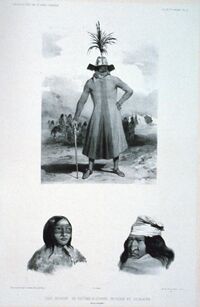Patagon
Topic: Earth
 From HandWiki - Reading time: 4 min
From HandWiki - Reading time: 4 min
The Patagones or Patagonian giants were a race of giant humans rumoured to be living in Patagonia and described in early European accounts. They were said to have exceeded at least double normal human height, with some accounts giving heights of 13 to 15 feet (4 to 4.5 m)[1] or more. Tales of these people would maintain a hold upon European conceptions of the region for nearly 300 years.[2]
History
The first mention of these people came from the voyage of Ferdinand Magellan and his crew, who claimed to have seen them while exploring the coastline of South America en route to the Maluku Islands in their circumnavigation of the world in the 1520s.[2] Antonio Pigafetta, one of the expedition's few survivors and the chronicler of Magellan's expedition, wrote in his account about their encounter with natives twice a normal person's height:
One day we suddenly saw a naked man of giant stature on the shore of the port, dancing, singing, and throwing dust on his head. The captain-general [i.e., Magellan] sent one of our men to the giant so that he might perform the same actions as a sign of peace. Having done that, the man led the giant to an islet where the captain-general was waiting. When the giant was in the captain-general's and our presence he marveled greatly, and made signs with one finger raised upward, believing that we had come from the sky. He was so tall that we reached only to his waist, and he was well proportioned...[1]
Pigafetta also recorded that Magellan had bestowed on these people the name "Patagão" (i.e. "Patagon", or Patagoni in Pigafetta's Italian plural), but he did not further elaborate on his reasons for doing so.[3] The original word would probably be in Ferdinand Magellan's native Portuguese (patagão) or the Spanish of his men (patagón). Since Pigafetta's time the assumption that this derived from pata or foot took hold, and "Patagonia" was interpreted to mean "Land of the Bigfeet". However, this etymology remains questionable, since amongst other things the meaning of the suffix -gon is unclear. It is now understood that the etymology refers to a literary character in a Spanish novel of the early 16th century.[4] Nevertheless, the name "Patagonia" stuck, as did the notion that the local inhabitants were giants. Early maps of the New World afterwards would sometimes attach the label regio gigantum ("region of giants") to the area.
In 1579, Francis Drake's ship chaplain, Francis Fletcher, wrote about meeting very tall Patagonians, of "7 foote and a halfe".[5]
In the 1590s, Anthony Knivet claimed he had seen dead bodies 12 feet (3.7 m) long in Patagonia.
Also in the 1590s, William Adams, an Englishman aboard a Netherlander ship rounding Tierra del Fuego, reported a violent encounter between his ship's crew and unnaturally tall natives.[citation needed]
The Dutch sailors Sebald de Weert in 1598, Olivier van Noort in 1599, and Joris van Spilbergen in 1615 claimed that giants were living in Patagonia.[1]
In 1766, a rumour leaked out upon their return to Great Britain that the crew of HMS Dolphin, captained by Commodore John Byron, had seen a tribe of 9-foot-tall (2.7 m) natives in Patagonia when they passed by there on their circumnavigation of the globe. However, when a newly edited revised account of the voyage came out in 1773, the Patagonians were recorded as being 6 feet 6 inches (1.98 m)—very tall, especially by 18th century standards, but by no means giants.
Explanations
In 1615, a grave with bones of the giants in Puerto Deseado was reported by Willem Schouten and Jacob Le Maire. This claim was possibly initiated by fossil finds.[1]
Later writers consider the Patagonian giants to have been a hoax, or at least an exaggeration and misreporting of earlier European accounts of the region.
These accounts may also refer to the Selk'nam people.[citation needed]. However, like that of the Tehuelche language, the language of the Selk'nam people does not match the records of the giant's language that Magellan is claimed to have encountered.[6][7] A photo of a seven-foot tall Selk'nam ("Ona") man can be found in the Library of Congress.[8]
See also
References
- ↑ 1.0 1.1 1.2 1.3 C. A. Brebbia (2007). Patagonia, a Forgotten Land: From Magellan to Perón. WIT Press. pp. 13–14. ISBN 9781845640613. https://books.google.com/books?id=nDDJAwAAQBAJ&dq=patagonians+15+feet&pg=PA14. Retrieved 2 October 2022.
- ↑ 2.0 2.1 William C. Sturtevant (1980). "Patagonian Giants and Baroness Hyde de Neuville's Iroquois Drawings". Ethnohistory 27 (4): 331–348. doi:10.2307/481730. https://www.jstor.org/stable/481730.
- ↑ Antonio Pigafetta, Relazione del primo viaggio intorno al mondo, 1524: "Il capitano generale nominò questi popoli Patagoni."
- ↑ Anthony Munday, The Famous and Renowned Historie of Primaleon of Greece, 1619, cap.XXXIII: "How Primaleon ... found the Grand Patagon".
- ↑ Brooke-Hitching, Edward (2018). The Phantom Atlas: The Greatest Myths, Lies and Blunders on Maps. Chronicle Books. p. 184. ISBN 9781452168449. https://books.google.com/books?id=rdA8DwAAQBAJ&pg=PA184. Retrieved 8 July 2019.
- ↑ https://archive.org/details/magellansvoyagea01piga_0/page/76/mode/2up?ref=ol&view=theater
- ↑ https://ids.clld.org/contributions/311
- ↑ Ona man, 7 ft. 4 in., standing Library of Congress. Retrieved 4 June 2019.
- "The Patagonian Giants". Museum of Hoaxes. http://www.museumofhoaxes.com/patagonia.html. Retrieved August 15, 2005.
- Carolyne Ryan. "European Travel Writings and the Patagonian giants". Lawrence University. Archived from the original on September 16, 2011. https://web.archive.org/web/20110916232605/http://www.lawrence.edu/news/pubs/lt/fall04/giants.shtml. Retrieved August 15, 2005.
 |
 KSF
KSF


